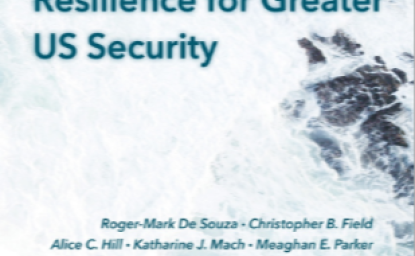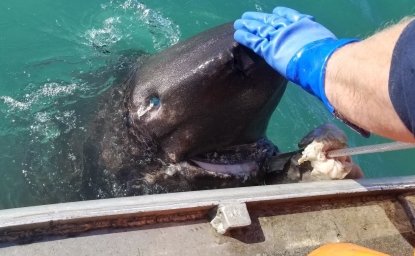As the Atlantic hurricane season kicks off this month, some coastal communities in the United States and small-island nations in the Caribbean are still recovering from last year’s record-breaking damage. At the same time, the heavy rains pounding the East Coast this week are part of a long-term trend towards more severe heavy rainfall events that have led to deadly floods and threaten critical U.S. military bases. Even on sunny days, cities such as Norfolk and Manila contend with high tide or “nuisance” flooding—a phenomenon that has increased as much as nine-fold since the 1960s, according to NOAA.
Extreme weather events like these not only endanger the billions of people who live along the world’s coastlines, they also undermine our national security, write the editors of a new report, “Building Coastal Resilience for Greater U.S. Security,” released this week by the Hoover Institution, the Stanford Woods Institute for the Environment, and the Woodrow Wilson Center.
The report is based on a series of discussions that focused on policy options to the challenges faced by coastal regions. Three of the report’s editors—Alice Hill, a research fellow at the Hoover Institution; Katharine Mach, a senior research scientist at Stanford’s School of Earth, Energy & Environmental Sciences; and Roger-Mark De Souza, president and CEO of Sister Cities International—answered questions on the report’s assessment of security risks from sea-level rise and extreme weather.
What makes coastal resilience a national security issue?
Hill: The U.S. Department of Defense has repeatedly identified climate change as a “threat multiplier” to national security. Three feet of sea-level rise would threaten 128 military installations, according to the Union of Concerned Scientists. For example, an important logistics hub on the Pacific island of Diego Garcia would be flooded if the sea level rises a few feet.
Mach: The security concerns are diverse. They range from the territorial integrity of nations through to the consequences of disasters for economies, cultures and societies.
De Souza: Coastal residents threatened by devastating storms and sea-level rise could be forced to seek shelter further inland or across borders, and this displacement—whether sudden or slow—could further destabilize already fragile countries. This political instability could combine with other problems to spur unrest that might spill over into larger conflicts or war.
What should we be doing and fixing – in terms of national and local policy – to meet these challenges?
Hill: Communities can examine their land-use and construction policies to avoid rebuilding in harm’s way. We should include future scenarios in Federal Emergency Management Agency floodplain map updates, limit coverage for repetitive flooding and stop offering below-market-rate policies for new construction in floodplains. Governments can incentivize adoption and enforcement of building codes which account for extreme weather scenarios and climate impacts. The private sector can incorporate climate risk into insurance coverage and provide premium savings to communities that take mitigation actions.
De Souza: The United States should recognize that helping vulnerable coastal countries—particularly small-island nations—adapt and prepare for the effects of climate change will reduce the burden on the U.S. military to respond to increasingly severe crises. By building resilience for coastal countries, we are also building peace.
What is managed retreat, and how should coastal communities be thinking about it?
Mach: Managed retreat is reducing risk by getting out of the way. Strategically relocating people and assets out of floodplains can be a cost-effective way to keep people safe. Managed retreat is often, in effect, a negotiation between a government and people at risk. An effective relocation process has to navigate everything from the role of property taxes in local economies to the psychological attachment people have to their homes.
De Souza: Managed retreat for the residents of small-island states is going to be quite different than for a coastal community on the mainland. The citizens of islands like the Maldives will lose not only their homes, but their country as well. In this context, effective relocation will need to include issues of sovereignty, citizenship, and compensation.
How can we address coastal resilience issues without alienating people who doubt the science of climate change and sea level rise?
Hill: We can focus on building resilience to the impacts that we are experiencing now, especially those that affect public health and our pocketbooks. We can start that discussion without even using the words “climate change.”
Mach: Climate change doesn’t always have to be part of the conversation. In many places throughout the U.S., people know they have a flooding problem. Last year, flooding from hurricanes, storm surges and heavy rain destroyed infrastructure, disrupted economies and jobs, took lives, and ran up a final multibillion-dollar bill that was record-setting. People are responding to the problem whether or not climate change is part of the conversation.
De Souza: People living on islands—whether small-island nations or part of the United States—have seen the changes with their own eyes. They have lived through the extreme storms and changing weather patterns that are affecting their lives and livelihoods. In some places they are also witnessing their ancestral lands and cultural heritage being washed away. By sharing their stories, we can help people see that building coastal resilience is protects health, home, and family.
Are there any silver-lining opportunities for coastal communities considering action to reduce risk?
Hill: Building resilience can bring multiple benefits, including strengthening the economy, protecting the environment and improving quality of life. Preparing for extremes can reduce recovery costs. On average, every dollar we invest in risk reduction saves $6 in damages. When communities make themselves more resilient, they can get back to business after a disaster faster. And the faster they get back to business, the stronger their communities become.
Mach: Managing coastal risks can result in valuable gains such as restoration of coastal wetlands and nature, infrastructure geared towards future sea level rise and laws and policies that provide needed flexibility through time.
De Souza: Coastal communities have a unique opportunity to learn from each other. People in Bangladesh’s floodplains, for example, have dealt with deadly floods for generations. What can we learn from their coping techniques as we face new but similar challenges in other parts of the world? By sharing lessons, we can build bridges between communities that can help them learn not only to be better prepared for climate change, but for all of our future shared challenges.
Other editors of the report include Christopher Field, director of the Stanford Woods Institute for the Environment; and Meaghan Parker of the Wilson Center and editor of the New Security Beat. Co-editors include Lea Rosenbohm of the Stanford Woods Institute and Stephanie Strazisar of the Hoover Institution.
This article first appeared New Security Beat






